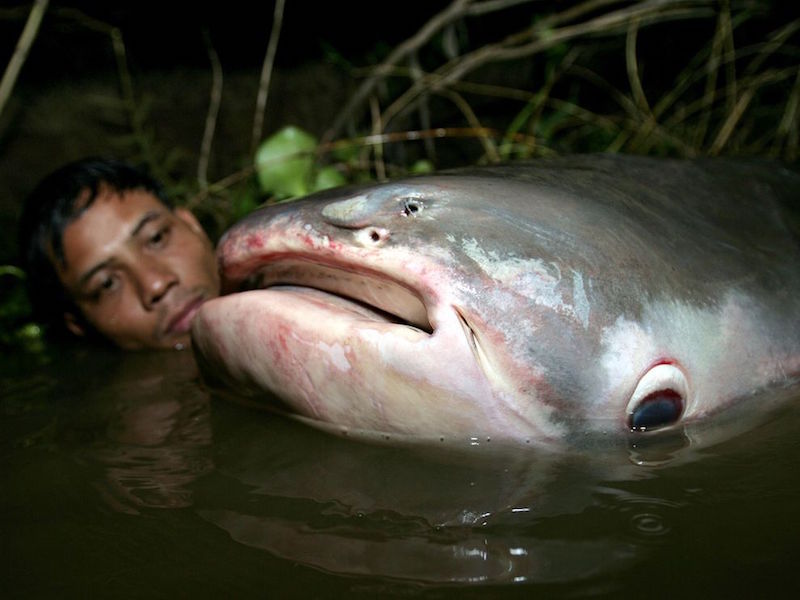Footnotes:
The Kali River Goonch

For communities living along the Kali River on the India-Nepal border, stories of a river monster have persisted for years. In 1988, the disappearance of a 17-year-old Nepalese boy kicked off a trend of attacks that lent some credence to the legends. Over time, however, those who witnessed or survived the attacks came to identify the attacker as a member of a massive species of catfish known locally as a goonch.
The goonch, like all catfish, is an ambush predator. Their diets aren’t restricted solely to fish. As seen above, catfish in general will consume birds, lizards, dogs…any animal they can overpower, should that animal be foolish enough to wonder too close to the water’s edge.
In 2010, biologist Jeremy Wade of River Monsters fame would confirm that goonch catfish living in the river could indeed grow large enough to kill and possibly eat a human. But what attracted them in the first place? The villagers living along the river believe their funeral rituals may have something to do with it, but attacks on humans by large species of catfish are common around the world.

The Sankebetsu Brown Bear Incident

In November of 1915, in the Sankebetsu settlement on the west coast of Hokkaido, Japan, an ussuri brown bear appeared on the outskirts of a farm. The farmer, concerned that the so-far peaceful animal might harm his family and his property, fired at and wounded the bear.
His hope was that the injury would frighten the bear and discourage it from coming near people in the future. He could not have been more wrong.

The bear may or may not have been Kesagake, a notorious man-eater named for the injuries he inflicted on his victims. Whether that man-eater and this one were one and the same, the farmer’s gunshot would kick off a killing spree that would take an army of men and a legendary bear hunter to finally bring to an end.

Lolong The Crocodile

In about 2009, the people of a town called Bunawan on the fringes of the Agusan Marsh in the Philippines began losing their livestock. These were no ordinary cattle, however. They were losing water buffalo.

It would take a Herculean feat of strength to dispatch such an animal, and witnesses claimed a massive crocodile was responsible. Shortly after, just such a crocodile decapitated an 11-year-old girl on her way home from school. The town had a man-eater on it’s hands.
But Lolong, the crocodile in question, was a rare species of saltwater crocodile and highly endangered. To kill such a crocodile, even a man-eater, is illegal. If the townspeople wanted to be rid of Lolong, they’d have to take him alive.
https://www.youtube.com/watch?v=6s4ndnuBKvY
And take him they did. It took an expert crocodile hunter and an entire village to capture the crocodile, but they were successful. He was monstrous in size, weighing over a ton and measuring out to 21 ft in length.
The people understood they had a truly spectacular animal on their hands, and they marched him to a tourist park near town where he could live out the rest of his days in captivity.

Lolong would survive there for 18 months before he perished from stress in 2013. Debates over how exactly Lolong died and whether he was cared for responsibly continue to this day. Furthering the mystery, no human or buffalo remains were found when they pumped his stomach after his capture. Note: The following video includes photos from the necropsy, which may be a little much for some.
Sources:
Reel-y? Giant Catfish Reportedly Caught In Italy by Greg Botelho and Joseph Netto
Mutant fish with taste for human flesh attacks swimmers in Indian river by Will Longbottom
Giant Man-Eating Catfish Finally Caught In Mekong River by World News Daily Report
Kesagake the Man Eater by Andrew Kincaid
Giant Crocodile Breaks Size Record – Suspected In Fatal Attacks by Christine Dell’Amore
Man-Eating Super Croc – Animal Planet Extreme (Available in full on Youtube – Low Quality)
What Really Killed Lolong? by Adam Britton
Museum Management:
Museum theme by Michael Guy Bowman
Listen to more at: bowman.bandcamp.com
Rachel: Designer #UkuleleWitch @rachelvice
Tour Guides: Emery Coolcats, CC, David Gimnich
Twitter: @natmysterycast | Email: natmysterypodcast@gmail.com | Home: pome-mag.com/category/pomecast
Museum of Natural Mystery is part of the POMEcast network, and thanks a million to the ladies of POME for helping this show get up and running! But above all, thank you for listening! We’ll see you next time!




